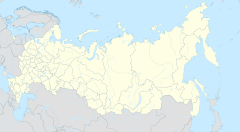Negatives
Location of the settlement area of the Negidals in Russia |
The negidals ( Russian Негидальцы / Negidalzy; derived from Evenki нге гида / length gida , "Coastal" or "valley residents"; negidalische proper name элькан бэйэнин / Elkan bejenin , "locals") are a small Tungusic people , traditionally on the middle and lower reaches of the left Amur tributary Amgun in the Far East of Russia , today's Rajon imeni Poliny Osipenko of the Khabarovsk region .
At the last census in 2010 there were 513 Negidals in Russia, of which 74 (14%; 1970 53%) still speak Negidal, a northern Tungusic language similar to Evenk . As a colloquial language, Negidial has largely been replaced by Russian. In the course of the last century the number of negidals has remained almost stable at a low level (1897: 423; 1926: 683 (without " assimilated " 426), 1959: 350, 1970: 537, 1979: 504, 1989: 622, 2002: 567 ).
According to local differences in culture, way of life and language in the area of the settlement area, lower reaches (Russian nisowskije ) and upper reaches negative (Russian werchowskije , based on the Amgun River) can be distinguished. With the Niederlaufs-Negidalen the traditional main livelihood is fishing over hunting; the most important means of transport are (sled) dogs; they lived sedentary, in winter in heated log huts , in summer in huts made of tree bark. With the upper reaches of the Negidals, the hunt as the basis of life, the reindeer as a means of transport the bigger role; they lived in portable Tschums . The negidals originally sewed their clothing from fish skin and animal skins, later also from fabrics of Manchurian , Chinese and Russian origins.
For a long time the Negidals have been in close cultural contact with other small indigenous peoples of the Amur region, such as Niwchen , Ultschen and Nanai .
Russians first met Negidals in the 17th century; Contacts only became closer from the middle of the 19th century. During this time, the ethnonym "Negidale" was introduced by Alexander Theodor von Middendorff . As a result, the Negidals took over the house types and clothes of the Russian settlers and began farming. They were officially regarded as converted to the Orthodox faith ; to this day, however, traditional ideas and customs of the original Siberian shamanism / animism are widespread. In the Soviet era , the Negidals were organized together with the Russian residents of the area in fishing, hunting and agricultural collective farms ( kolkhozes ).
The Negidals are represented in the Russian Association of Indigenous Peoples of the North ( RAIPON ).
Individual evidence
- ↑ a b Red Book of the Ethnicities of the Russian Federation , s. Web links
- ↑ Results of the 2010 Census, Volume 4 (Russian)
- ↑ Census data for the small indigenous peoples at demoscope.ru for the entire USSR (Russian); In 1989 35 of them lived outside the RSFSR ; in the censuses of 1939 (no information) and 1959 (estimate) the negidals were also recorded as Evenks
- ↑ Negidalen ( Memento of the original from June 9, 2011 in the Internet Archive ) Info: The archive link was inserted automatically and has not yet been checked. Please check the original and archive link according to the instructions and then remove this notice. on the RAIPON website (in Russian)
literature
- Narody Rossii: ėncyklopedija . Bolʹšaja rossijskaja ėncyklopedija, Moscow 1994, ISBN 5-85270-082-7 ( Peoples of Russia: Encyclopedia ; Russian).
Web links
- Negidals in the Red Book of ethnic groups of the Russian Federation (English)
- The Udegejzen, Negidalzen, Orotschen and Tasen Report from the radio station "Voice of Russia"
